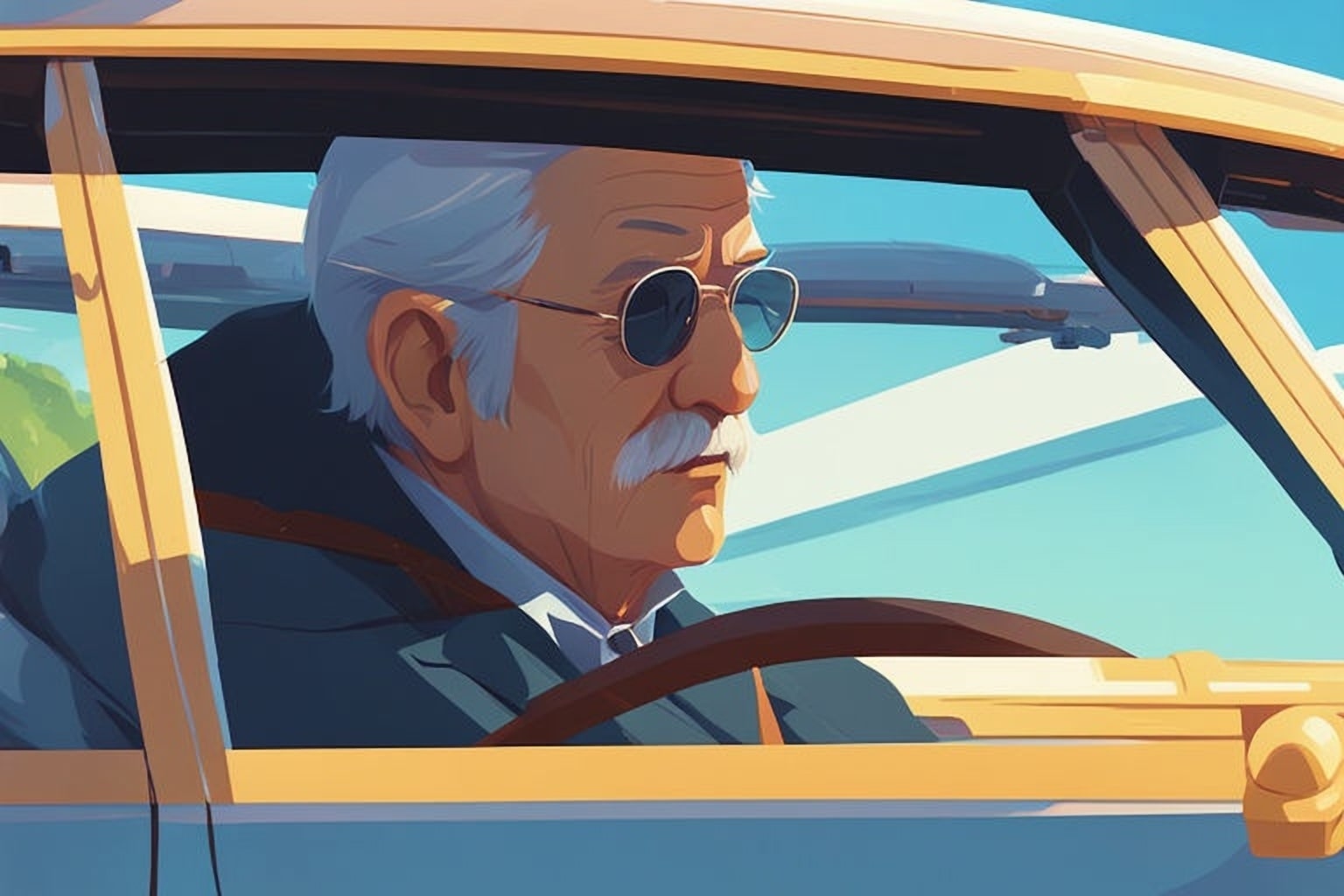BeatDrivingAnxiety.com highly recommends The Driving Fear Program to overcome your Driving Anxiety
-->Click Here<--

Driving anxiety is a common challenge that individuals of all ages can face. Whether it’s the fear of navigating busy highways, parallel parking, or simply getting behind the wheel, this anxiety can significantly impact one’s quality of life and independence. However, it’s important to recognize that this fear is not insurmountable, and with the right mindset and strategies, it can be conquered.
Overcoming driving anxiety is particularly crucial for older adults, as maintaining the ability to drive is often essential for preserving their independence and freedom. The loss of driving privileges can lead to social isolation, reduced access to essential services, and a diminished sense of self-reliance. By addressing and conquering this fear, older adults can regain their mobility, expand their horizons, and enjoy a higher quality of life.
The benefits of conquering driving anxiety are numerous. Improved confidence and control behind the wheel can lead to a greater sense of security, reduced stress, and the ability to navigate one’s surroundings with ease. Additionally, the freedom to drive can open up new opportunities for social engagement, access to healthcare, and the pursuit of hobbies and interests. By embracing the road ahead, individuals can reclaim their independence and actively participate in their communities, ultimately enhancing their overall well-being.
Overcoming Driving Anxiety as an Adult – Key Takeaways
- Driving anxiety can be conquered at any age, and it’s never too late to regain confidence behind the wheel.
- Mature drivers can overcome the stigma associated with age and driving by focusing on building their confidence and skills.
- Practical strategies, such as deep breathing and visualization, can help anxious drivers regain control and ease their anxiety.
- Adult learners can build confidence by practicing in low-stress environments and seeking professional instruction.
- Addressing age-related driving concerns involves acknowledging and adapting to changes in physical abilities and cognitive function.
Overcoming the Stigma: Driving Confidence for the Mature Driver
Older drivers often face unfair stereotypes and misconceptions about their driving abilities. The perception that they are inherently less capable or more dangerous on the road can be a significant barrier to their confidence and willingness to drive. However, it’s important to recognize that age alone does not determine one’s driving skills or safety record.
Many mature drivers possess a wealth of experience and wisdom that can contribute to their driving prowess. They may have developed a keen sense of situational awareness, patience, and decision-making skills that can make them safer and more cautious on the road. By embracing their desire to learn and improve their driving skills, older adults can challenge these stereotypes and demonstrate their ability to navigate the roads with confidence.
Encouraging adult learners to pursue driving education and training can be a powerful way to overcome the stigma surrounding older drivers. Programs designed specifically for mature drivers can provide a supportive and non-judgmental environment, where they can learn at their own pace and receive personalized guidance. This can help build their confidence, address any specific concerns or weaknesses, and ultimately, empower them to reclaim their rightful place on the road.

Practical Tips for Regaining Control: Strategies to Ease Driving Anxiety
Conquering driving anxiety requires a systematic and gradual approach. Developing a step-by-step plan can be an effective way to build confidence behind the wheel. This may involve starting with simple tasks, such as practicing in a familiar and low-stress environment, and gradually increasing the complexity of driving situations as one becomes more comfortable.
Incorporating relaxation techniques, such as deep breathing and visualization, can also be a powerful tool in managing driving anxiety. By learning to calm the mind and body, individuals can better navigate the challenges they may face on the road. Visualization exercises, where one imagines successfully navigating a driving scenario, can help to reframe negative thought patterns and boost self-assurance.
Practicing in a variety of driving conditions, from quiet residential streets to bustling highways, can also help to build confidence and prepare individuals for the real-world challenges they may encounter. This gradual exposure can help to desensitize the individual to their fears and allow them to develop the necessary skills and coping mechanisms to manage their anxiety.
Building Confidence Behind the Wheel: Techniques for Adult Learners
Identifying and addressing the specific fears or concerns that contribute to driving anxiety is a crucial step in the process of building confidence behind the wheel. This may involve exploring the root causes of one’s anxiety, such as a past traumatic experience, a lack of confidence in one’s abilities, or concerns about age-related changes.
Practicing mindfulness and positive self-talk can also be effective in overcoming negative thought patterns that can undermine driving confidence. By cultivating a more positive and resilient mindset, individuals can learn to reframe their experiences and focus on their strengths and capabilities.
Seeking the guidance of a patient and experienced driving instructor can be invaluable for adult learners. These professionals can provide personalized instruction, tailored to the individual’s needs and learning style. They can also offer constructive feedback, encouragement, and strategies for managing anxiety, ultimately helping the learner to develop the skills and confidence necessary to navigate the roads safely and effectively.
Navigating the Challenges: Addressing Age-Related Driving Concerns
| Age Group | Percentage of Adults with Driving Anxiety |
|---|---|
| 18-29 | 15% |
| 30-39 | 12% |
| 40-49 | 10% |
| 50-59 | 8% |
| 60+ | 5% |
As individuals age, they may experience physical changes that can impact their driving abilities, such as diminished vision, slower reaction times, or reduced mobility. Acknowledging and addressing these changes is crucial for maintaining safe driving practices and preserving one’s independence.
Exploring adaptive technologies and vehicle modifications can be a game-changer for older drivers. Features like backup cameras, lane departure warning systems, and adjustable seats and pedals can help to compensate for age-related changes and enhance driving safety. By staying informed about the latest advancements in automotive technology, older adults can adapt their driving habits and maintain their mobility.
Developing a plan to regularly assess and maintain driving skills is also essential as one ages. This may involve periodic driving evaluations, refresher courses, or consultations with healthcare professionals to ensure that one’s abilities remain up to par. By proactively addressing any changes or concerns, older adults can continue to drive safely and confidently, preserving their independence and quality of life.
Seeking Support: Resources and Guidance for Anxious Adult Drivers
Overcoming driving anxiety can be a challenging and isolating experience, but it’s important for individuals to know that they are not alone. Connecting with support groups or online communities for adult drivers with anxiety can provide a sense of camaraderie, shared experiences, and practical advice from those who have been on a similar journey.
Exploring counseling or therapy options can also be a valuable resource for addressing the emotional aspects of driving anxiety. Mental health professionals can help individuals to identify the root causes of their fears, develop coping strategies, and build the resilience necessary to confront their driving challenges.
In addition to emotional support, individuals can also seek out local driving schools or programs specifically designed for mature drivers. These specialized programs can offer a supportive and non-judgmental environment, where older adults can learn at their own pace and receive personalized guidance from experienced instructors. By tapping into these resources, anxious adult drivers can take the first steps towards regaining their confidence and independence on the road.
Adapting to Change: Embracing New Technologies and Driving Techniques
As technology continues to evolve, the driving experience is also undergoing significant changes. Exploring the benefits of advanced driver assistance systems and in-vehicle technologies can be a game-changer for older adults who are seeking to enhance their driving safety and confidence.
Features like automatic emergency braking, lane-keeping assistance, and adaptive cruise control can help to compensate for age-related changes and provide an extra layer of protection on the road. By embracing these technological advancements, older drivers can feel more secure and in control, allowing them to focus on the task at hand rather than constantly worrying about potential hazards.
In addition to technological adaptations, incorporating new driving techniques, such as defensive driving or eco-friendly driving, can also contribute to a more confident and competent driving experience. These techniques can help individuals to anticipate and respond to potential hazards, as well as to develop a more efficient and environmentally-conscious driving style.
Staying informed about changes in traffic laws and regulations is also crucial for maintaining compliance and ensuring safe driving practices. By regularly updating their knowledge and adapting to new requirements, older adults can demonstrate their commitment to responsible driving and continue to navigate the roads with confidence.
Maintaining Independence: The Importance of Driving for Older Adults
Driving is not just a means of transportation; it is a crucial component of an older adult’s overall well-being and independence. The ability to drive provides a sense of freedom, control, and connection to the world around them, allowing them to access essential services, participate in social activities, and maintain their quality of life.
The challenges faced by older adults who are unable to drive can be significant, leading to social isolation, reduced access to healthcare, and a diminished sense of self-reliance. This can have a profound impact on their mental and physical health, as well as their overall quality of life.
Recognizing the importance of driving for older adults, it is essential for families and communities to provide support and resources to help them maintain their driving skills and independence. This may involve assisting with transportation alternatives, advocating for age-friendly infrastructure, or connecting them with driving programs and support services.
By prioritizing the driving needs of older adults and empowering them to remain behind the wheel, we can help to preserve their autonomy, foster their social connections, and ensure that they can continue to actively participate in their communities. This, in turn, can have a positive impact on their overall well-being and quality of life.
Embracing the Journey: Celebrating Milestones and Achievements on the Road
Overcoming driving anxiety is a courageous and deeply personal journey, and it’s important to acknowledge the determination and resilience required to confront this challenge. Each small victory, whether it’s completing a driving course, navigating a challenging route, or simply feeling more at ease behind the wheel, is a testament to the individual’s hard work and commitment.
Celebrating these milestones and achievements can be a powerful way to reinforce one’s progress and build momentum towards greater confidence and independence. By acknowledging and applauding the steps taken along the way, individuals can develop a greater sense of self-assurance and pride in their accomplishments.
Encouraging individuals to share their stories and inspire others who are on a similar journey can also be a valuable way to foster a sense of community and mutual support. By sharing their experiences, challenges, and triumphs, anxious adult drivers can help to normalize the experience, provide hope and encouragement to others, and contribute to a more inclusive and understanding driving culture.
Embracing the journey towards conquering driving anxiety is a testament to the human spirit and the power of determination. By celebrating the milestones and achievements along the way, individuals can find the strength and motivation to continue pushing forward, ultimately reclaiming their independence and enjoying the freedom and fulfillment that comes with being behind the wheel.
Overcoming Driving Anxiety as an Adult – FAQs
What is driving anxiety?
Driving anxiety, also known as vehophobia, is a fear of driving that can range from mild unease to a debilitating phobia. It can be triggered by a variety of factors, including accidents, traffic, or even just the act of getting behind the wheel.
What are the symptoms of driving anxiety?
Symptoms of driving anxiety can include sweating, rapid heartbeat, trembling, shortness of breath, and a feeling of dread or panic. Some individuals may also experience avoidance behaviors, such as refusing to drive or only driving on certain routes.
How common is driving anxiety in adults?
Driving anxiety is relatively common in adults, with studies suggesting that it affects around 30% of the population. It can occur in individuals of any age, but it is often more prevalent in older adults who may have developed the fear over time.
What are some strategies for overcoming driving anxiety?
There are several strategies that can help individuals overcome driving anxiety, including gradual exposure to driving, relaxation techniques such as deep breathing or meditation, cognitive-behavioral therapy, and seeking support from a therapist or support group.
Is it possible to overcome driving anxiety as an adult?
Yes, it is possible to overcome driving anxiety as an adult. With the right support, strategies, and determination, many individuals are able to gradually reduce their fear and regain confidence behind the wheel. It may take time and effort, but it is achievable.
BeatDrivingAnxiety.com highly recommends The Driving Fear Program to overcome your Driving Anxiety
-->Click Here<--



